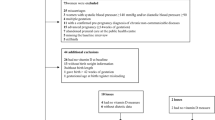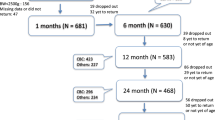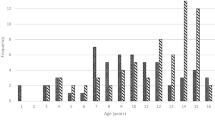Abstract
BACKGROUND/OBJECTIVES:
Compromised vitamin D status is common in pregnancy and may have adverse impacts on fetal development. The purpose of this study was to investigate the association of infant whole-body bone mineral content (WBBMC) at 8–21 days of age with feto-maternal vitamin D status in a multiethnic population in Oakland, California.
SUBJECTS/METHODS:
This was a cross-sectional study of 120 women and their newborn infants. Maternal and cord blood were collected at delivery. WBBMC was measured by dual-energy X-ray absorptiometry in term-born infants 8–21days post birth.
RESULTS:
No significant association was observed between unadjusted or size-adjusted WBBMC and feto-maternal vitamin D status analyzed continuously or categorically. In multivariate modeling, unadjusted WBBMC was predicted by bone area (P<0.0001), weight-for-age (P<0.0001) and weight-for-length (P=0.0005) Z-scores, but not by feto-maternal vitamin D status. Anthropometric predictors but not vitamin D remained significant in the multivariate model after adjustment of WBBMC for weight, bone area (bone mineral density) or logarithmically derived exponents of the denominators.
CONCLUSIONS:
Results of the present study do not support an association between feto-maternal vitamin D status and early infant WBBMC, raw or adjusted for inter-individual differences in size, in a multiethnic population in Northern California.
This is a preview of subscription content, access via your institution
Access options
Subscribe to this journal
Receive 12 print issues and online access
$259.00 per year
only $21.58 per issue
Buy this article
- Purchase on Springer Link
- Instant access to full article PDF
Prices may be subject to local taxes which are calculated during checkout

Similar content being viewed by others
References
Namgung R, Tsang RC . Factors affecting newborn bone mineral content: in utero effects on newborn bone mineralization. Proc Nutr Soc 2000; 59: 55–63.
Sayers A, Tobias JH . Estimated maternal ultraviolet B exposure levels in pregnancy influence skeletal development of the child. J Clin Endocrinol Metab 2009; 94: 765–771.
Winsloe C, Earl S, Dennison EM, Cooper C, Harvey NC . Early life factors in the pathogenesis of osteoporosis. Curr Osteoporos Rep 2009; 7: 140–144.
Martin R, Harvey NC, Crozier SR, Poole JR, Javaid MK, Dennison EM et al. Placental calcium transporter (PMCA3) gene expression predicts intrauterine bone mineral accrual. Bone 2007; 40: 1203–1208.
Morley R, Carlin JB, Pasco JA, Wark JD . Maternal 25-hydroxyvitamin D and parathyroid hormone concentrations and offspring birth size. J Clin Endocrinol Metab 2006; 91: 906–912.
Namgung R, Tsang RC, Lee C, Han DG, Ho ML, Sierra RI . Low total body bone mineral content and high bone resorption in Korean winter-born versus summer-born newborn infants. J Pediatr 1998; 132: 421–425.
Viljakainen HT, Saarnio E, Hytinantti T, Miettinen M, Surcel H, Makitie O et al. Maternal vitamin D status determines bone variables in the newborn. J Clin Endocrinol Metab 2010; 95: 1749–1757.
Akcakus M, Koklu E, Budak N, Kula M, Kurtoglu S, Koklu S . The relationship between birthweight, 25-hydroxyvitamin D concentrations and bone mineral status in neonates. Ann Trop Paediatr 2006; 26: 267–275.
Hannan MT, Litman HJ, Araujo AB, McLennan CE, McLean RR, McKinlay JB et al. Serum 25-hydroxyvitamin D and bone mineral density in a racially and ethnically diverse group of men. J Clin Endocrinol Metab 2008; 93: 40–46.
Weiler H, Fitzpatrick-Wong S, Veitch R, Kovacs H, Schellenberg J, McCloy U et al. Vitamin D deficiency and whole-body and femur bone mass relative to weight in healthy newborns. CMAJ 2005; 172: 757–761.
Dror DK, King JC, Durand DJ, Allen LH . Association of modifiable and nonmodifiable factors with vitamin D status in pregnant women and neonates in Oakland, CA. J Am Diet Assoc 2011; 111: 111–116.
de Onis M, Onyango AW, Van den Broeck J, Chumlea WC, Martorell R . Measurement and standardization protocols for anthropometry used in the construction of a new international growth reference. Food Nutr Bull 2004; 25: S27–S36.
Gordon CM, Bachrach LK, Carpenter TO, Crabtree N, El-Hajj Fuleihan G, Kutilek S et al. Dual energy X-ray absorptiometry interpretation and reporting in children and adolescents: the 2007 ISCD Pediatric Official Positions. J Clin Densitom 2008; 11: 43–58.
Kramer MS, Platt RW, Wen SW, Joseph KS, Allen A, Abrahamowicz M et al. A new and improved population-based Canadian reference for birth weight for gestational age. Pediatrics 2001; 108: E35.
Z-score data files (database on the Internet). Centers for Disease Control and Prevention, National Center for Health Statistics. (cited 1 May 2011). Available from http://www.cdc.gov/growthcharts/zscore.htm.
Mahon P, Harvey N, Crozier S, Inskip H, Robinson S, Arden N et al. Low maternal vitamin D status and fetal bone development: cohort study. J Bone Miner Res 2010; 25: 14–19.
Newhook LA, Sloka S, Grant M, Randell E, Kovacs CS, Twells LK . Vitamin D insufficiency common in newborns, children and pregnant women living in Newfoundland and Labrador, Canada. Matern Child Nutr 2009; 5: 186–191.
Molgaard C, Thomsen BL, Michaelsen KF . Whole body bone mineral accretion in healthy children and adolescents. Arch Dis Child 1999; 81: 10–15.
Acknowledgements
We wish to acknowledge the financial support for this study from the USDA, ARS Western Human Nutrition Research Center and the East Bay Neonatology Foundation. We extend a special thanks to Janet M Peerson at UC Davis for her assistance with statistical analyses.
Author information
Authors and Affiliations
Corresponding author
Ethics declarations
Competing interests
The authors declare no conflict of interest.
Rights and permissions
About this article
Cite this article
Dror, D., King, J., Durand, D. et al. Feto-maternal vitamin D status and infant whole-body bone mineral content in the first weeks of life. Eur J Clin Nutr 66, 1016–1019 (2012). https://doi.org/10.1038/ejcn.2012.79
Received:
Revised:
Accepted:
Published:
Issue Date:
DOI: https://doi.org/10.1038/ejcn.2012.79
Keywords
This article is cited by
-
Longitudinal measures of maternal vitamin D and neonatal body composition
European Journal of Clinical Nutrition (2019)
-
Maternal vitamin D supplementation in pregnancy and offspring outcomes: a double-blind randomized placebo-controlled trial
Journal of Bone and Mineral Metabolism (2017)
-
Maternal vitamin D status in pregnancy and offspring bone development: the unmet needs of vitamin D era
Osteoporosis International (2014)



